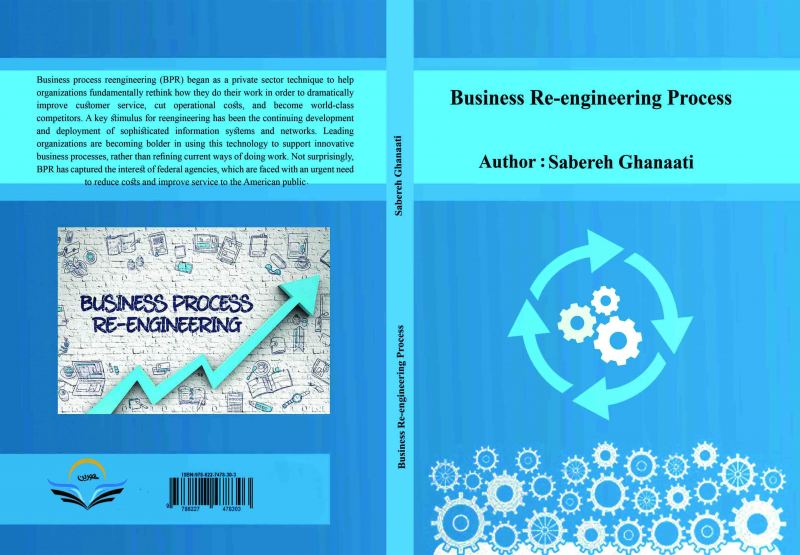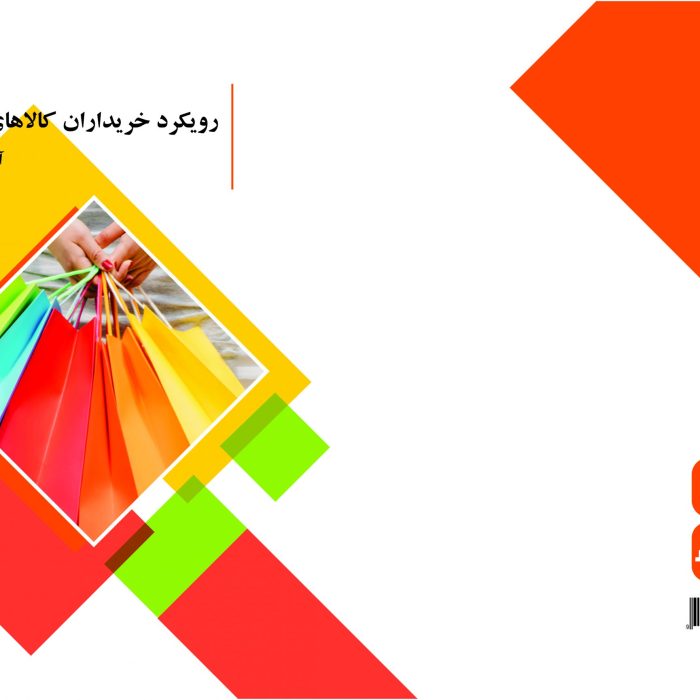کتاب Business Re-engineering Process
- صفحه نخست
- رشته ها
- علوم پزشکی
- پزشکی
- کتاب Business Re-engineering Process
کتاب Business Re-engineering Process
۵۵۰,۰۰۰ تومان Original price was: ۵۵۰,۰۰۰ تومان.۳۶۳,۰۰۰ تومانCurrent price is: ۳۶۳,۰۰۰ تومان.
| تعداد صفحات | 275 |
|---|---|
| شابک | 978-622-378-328-9 |
| انتشارات |

کتاب Business Re-engineering Process
درباره کتاب
کتاب Business Re-engineering Process یک راهنمای جامع در زمینه مهندسی مجدد فرآیندهای کسبوکار (BPR) است که به بررسی اصول، مبانی و روشهای نوین برای بهبود و بازسازی فرآیندهای تجاری میپردازد. این کتاب با ارائه مباحث مختلفی از جمله تاریخچه، مفاهیم پایه، نقش فناوری اطلاعات و تحلیلهای عملی، به مدیران، مشاوران و دانشجویان کمک میکند تا درک عمیقی از فرآیندهای تغییر سازمانی و بهبود مستمر پیدا کنند. همچنین، این کتاب به تحلیل عوامل موفقیت و شکست در مهندسی مجدد فرآیندهای کسبوکار و بررسی ابعاد مختلف این حوزه میپردازد.
موضوعات کلیدی کتاب
- مفاهیم و تاریخچه BPR: در فصلهای ابتدایی، تاریخچه و مفاهیم پایهای مهندسی مجدد فرآیندها معرفی میشود. این بخش به تحلیل مفاهیمی مانند خودکارسازی، بازسازی و اصول اولیه BPR میپردازد.
- نقش فناوری اطلاعات: این کتاب بهویژه به نقش اساسی فناوری اطلاعات در موفقیت BPR توجه دارد و میپردازد به این که چگونه استفاده از فناوری میتواند بهطور مؤثر فرآیندهای کسبوکار را تغییر دهد و بهبود بخشد.
- چارچوب و عوامل موفقیت: یکی از بخشهای مهم کتاب، بررسی عوامل حیاتی موفقیت و شکست در پیادهسازی BPR است. این عوامل شامل تعهد سازمانی، تجزیه و تحلیل نیازهای کسبوکار، و تغییرات مؤثر در مدیریت هستند.
- روشها و ابزارهای BPR: کتاب روشهای مختلفی برای اجرای BPR مانند نقشهبرداری فرآیندهای کسبوکار، بهبود فرآیند (BPI)، خودکارسازی فرآیند (BPA) و مهندسی مجدد فرآیندهای کسبوکار (BPR) را توضیح میدهد. همچنین، در این بخش به تحلیل تفاوتهای BPR با TQM (مدیریت کیفیت جامع) پرداخته میشود.
- نقد و ارزیابی: کتاب همچنین نقدهایی از دیدگاههای مختلف و نقدهایی درباره اجرا و چالشهای BPR در سازمانها دارد. این بخش به خوانندگان کمک میکند تا از تجربیات قبلی در این زمینه بهرهبرداری کنند.
ویژگیهای کلیدی کتاب
- نکات عملی و کاربردی: کتاب Business Re-engineering Process بهطور خاص بر روی نحوه پیادهسازی مؤثر BPR تمرکز دارد و برای مدیران و متخصصان این حوزه، راهکارهای عملی و استراتژیک را بهصورت گام به گام بیان میکند.
- تحلیل مقایسهای BPR و TQM: یکی از ویژگیهای برجسته این کتاب، مقایسه دقیق میان BPR و TQM است که بهطور مفصل تفاوتهای کلیدی این دو رویکرد را توضیح میدهد.
- مطالعه موردی: کتاب شامل مطالعات موردی و مثالهای واقعی از شرکتها و سازمانهای مختلف است که مهندسی مجدد فرآیندهای کسبوکار را بهطور موفقیتآمیز یا ناکام پیادهسازی کردهاند.
- توجه ویژه به فرهنگ سازمانی: یکی از جنبههای برجسته این کتاب، تحلیل تأثیر فرهنگ سازمانی بر موفقیت BPR است. این بخش بهویژه برای سازمانهای بزرگ و پیچیده اهمیت دارد.
چرا باید این کتاب را خواند؟
کتاب Business Re-engineering Process برای مدیران اجرایی، مشاوران کسبوکار، و افرادی که به دنبال بهبود عملکرد سازمانی از طریق مهندسی مجدد فرآیندها هستند، یک منبع ضروری است. این کتاب به خوانندگان کمک میکند تا استراتژیهای مناسب برای پیادهسازی BPR را بیاموزند و از اشتباهات رایج در این زمینه پرهیز کنند. همچنین، این کتاب میتواند به دانشجویان مدیریت کسبوکار و مهندسی صنایع که بهدنبال درک بهتر از BPR هستند، مفید واقع شود.
مخاطبان هدف
- مدیران اجرایی و مشاوران کسبوکار: این کتاب برای مدیرانی که به دنبال بهبود فرآیندها و افزایش بهرهوری سازمان خود هستند، مناسب است.
- دانشجویان و پژوهشگران مدیریت و مهندسی صنایع: کسانی که در حال تحصیل در رشتههای مدیریت کسبوکار، مهندسی صنایع، و فناوری اطلاعات هستند، میتوانند از این کتاب بهعنوان یک منبع علمی و عملی استفاده کنند.
- متخصصان فناوری اطلاعات و سیستمهای اطلاعاتی: کتاب بهویژه برای افرادی که در زمینههای مرتبط با سیستمهای اطلاعاتی و فناوری در سازمانها فعالیت میکنند، مفید است.
سفارش کتاب
برای خرید نسخه چاپی یا دیجیتال کتاب Business Re-engineering Process، میتوانید به فروشگاههای آنلاین معتبر یا کتابفروشیهای تخصصی مراجعه کنید.
1. کتاب “Business Re-engineering Process” به چه موضوعاتی پرداخته است؟
این کتاب به فرآیند بازمهندسی کسبوکار (BPR) و نحوه اجرای آن در سازمانها میپردازد. مباحثی همچون تاریخچه BPR، اهمیت فناوری اطلاعات، چگونگی تحلیل نیازهای کسبوکار، و شیوههای بهبود فرآیندهای تجاری از جمله اصول اصلی این کتاب است. 📘
2. در فصل اول کتاب چه مباحثی مطرح شده است؟
فصل اول به معرفی بازمهندسی کسبوکار پرداخته و تاریخچه این فرآیند، نقش فناوری اطلاعات در آن و روشهای تحقیق و متدولوژیهای مختلف را شرح میدهد. این فصل بهطور کلی بنیانگذاری بازمهندسی را توضیح میدهد. 🏗️
3. کتاب چگونه به بررسی عوامل موفقیت و شکست در BPR پرداخته است؟
فصل دوم کتاب عوامل موفقیت و شکست در فرآیند بازمهندسی را بررسی میکند. این عوامل شامل تعهد سازمانی، ترکیب تیم، تحلیل نیازهای کسبوکار، زیرساختهای IT مناسب، مدیریت تغییر موثر، و بهبود مستمر میباشد. 💡
4. BPR چیست و چرا در سازمانها ضروری است؟
BPR یا بازمهندسی فرآیندهای کسبوکار به بازنگری و بهبود مجدد فرآیندهای کلیدی یک سازمان بهطور ریشهای و بنیادین گفته میشود. هدف از BPR، افزایش کارایی، کاهش هزینهها، و بهبود کیفیت است. 🌟
5. در فصل سوم کتاب چه مباحثی درباره فرآیندهای کسبوکار آورده شده است؟
فصل سوم کتاب به توضیح فرآیندهای کسبوکار میپردازد. این فصل شامل مثالهایی از فرآیندهای کسبوکار همچون فرآیند جذب مشتری، بازاریابی محتوا، و نقشهبرداری فرآیندهای کسبوکار میباشد. همچنین به بهبود، اتوماسیون، و بازمهندسی فرآیندها پرداخته است. 🔄
6. چه تفاوتهایی بین بازمهندسی فرآیند کسبوکار (BPR) و مدیریت کیفیت کل (TQM) وجود دارد؟
در فصل ششم، کتاب به مقایسه بین TQM و BPR پرداخته است. BPR بیشتر به تغییرات بنیادین و رادیکال در فرآیندهای کسبوکار تمرکز دارد، در حالی که TQM بیشتر به بهبود مستمر و تدریجی کیفیت پرداخته و بر رضایت مشتری تأکید دارد. 📊
7. چگونه میتوان فرآیندهای کسبوکار را تحلیل و بهبود داد؟
در فصلهای مختلف، کتاب به روشهای تحلیل و بهبود فرآیندهای کسبوکار مانند “As-Is” و “To-Be” پرداخته است. همچنین، تحلیل شکافها و تدوین طرح عمل برای انتقال به فرآیند جدید، جزو اصول مطرح شده است. 🛠️
8. آیا این کتاب به بررسی مشکلات انسانی در BPR نیز پرداخته است؟
بله، در فصل دهم، کتاب به عوامل انسانی در BPR، از جمله مقاومت در برابر تغییر، نقش کارکنان در فرآیند بازمهندسی، و چگونگی مدیریت این تغییرات پرداخته است. 🧑🤝🧑
9. آیا این کتاب شامل مثالهای عملی از BPR است؟
بله، کتاب شامل مثالهای متعددی از فرآیندهای بازمهندسی کسبوکار، از جمله مطالعه موردی از اجرای BPR در شرکتها و سازمانها است که چگونگی پیادهسازی موفق آن را نشان میدهد. 📈
10. در نهایت، کتاب چه توصیههایی برای سازمانها در رابطه با BPR ارائه میدهد؟
کتاب در نهایت به سازمانها توصیه میکند که در فرآیند BPR توجه ویژهای به استراتژی کسبوکار، فرهنگ سازمانی، و تکنولوژی اطلاعات داشته باشند. همچنین تأکید دارد که بازمهندسی باید بهطور مستمر ارزیابی و اصلاح شود تا از موفقیت آن اطمینان حاصل شود. 🔍
| تعداد صفحات | 275 |
|---|---|
| شابک | 978-622-378-328-9 |
| انتشارات |
.فقط مشتریانی که این محصول را خریداری کرده اند و وارد سیستم شده اند میتوانند برای این محصول دیدگاه ارسال کنند.
محصولات مشابه
-
کتاب رویکرد خریداران کالای لوکس
۱۶۰,۰۰۰ تومانOriginal price was: ۱۶۰,۰۰۰ تومان.۱۰۵,۶۰۰ تومانCurrent price is: ۱۰۵,۶۰۰ تومان. -
کتاب تأثیر یادگیری سازمانی و خلاقیت سازمانی بر نوآوری سازمانی
۲۴۰,۰۰۰ تومانOriginal price was: ۲۴۰,۰۰۰ تومان.۱۵۸,۴۰۰ تومانCurrent price is: ۱۵۸,۴۰۰ تومان. -
کتاب رابطه سرمایه روانشناختی با عملکرد سازمانی
۱۷۲,۰۰۰ تومانOriginal price was: ۱۷۲,۰۰۰ تومان.۱۱۳,۵۲۰ تومانCurrent price is: ۱۱۳,۵۲۰ تومان.







دیدگاهها
هیچ دیدگاهی برای این محصول نوشته نشده است.